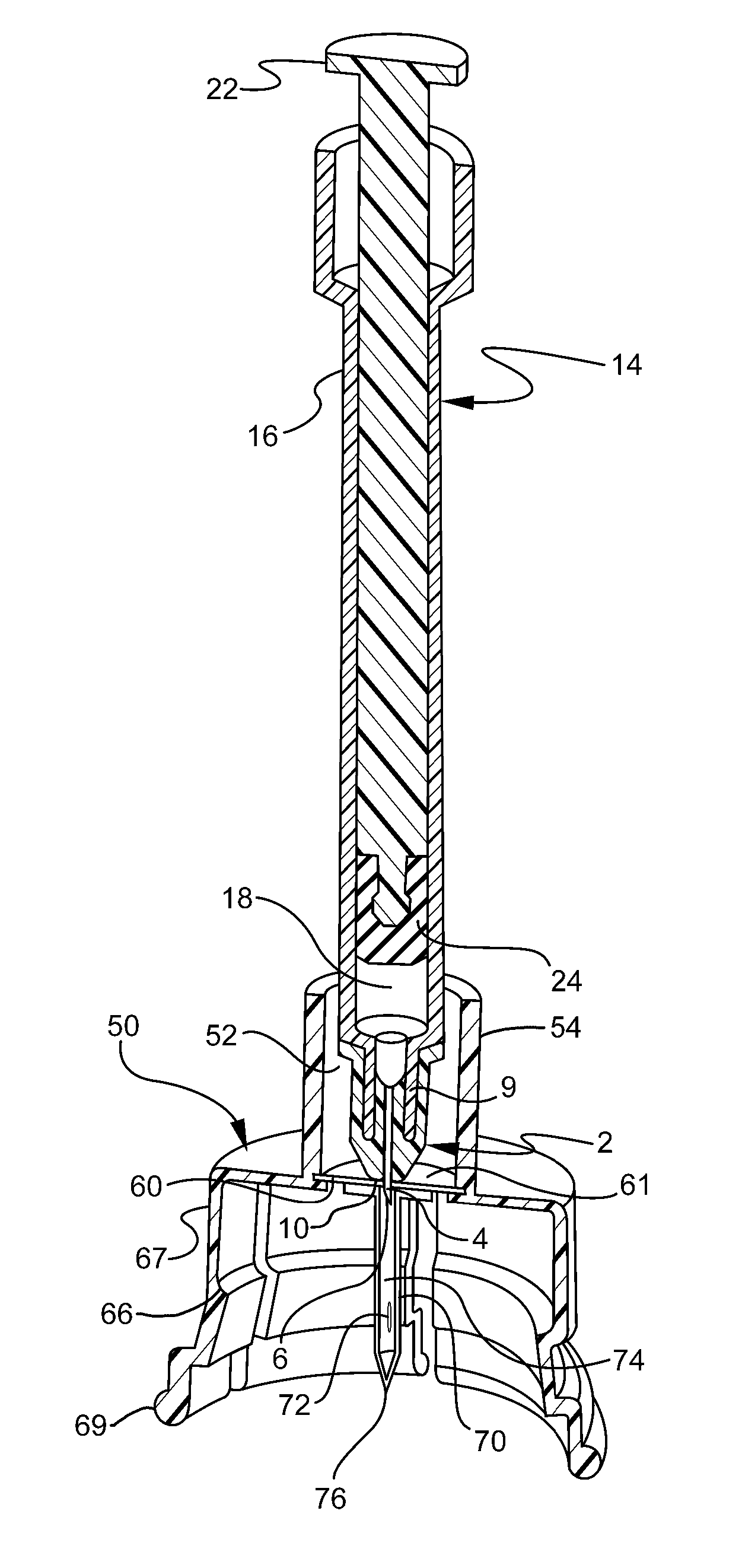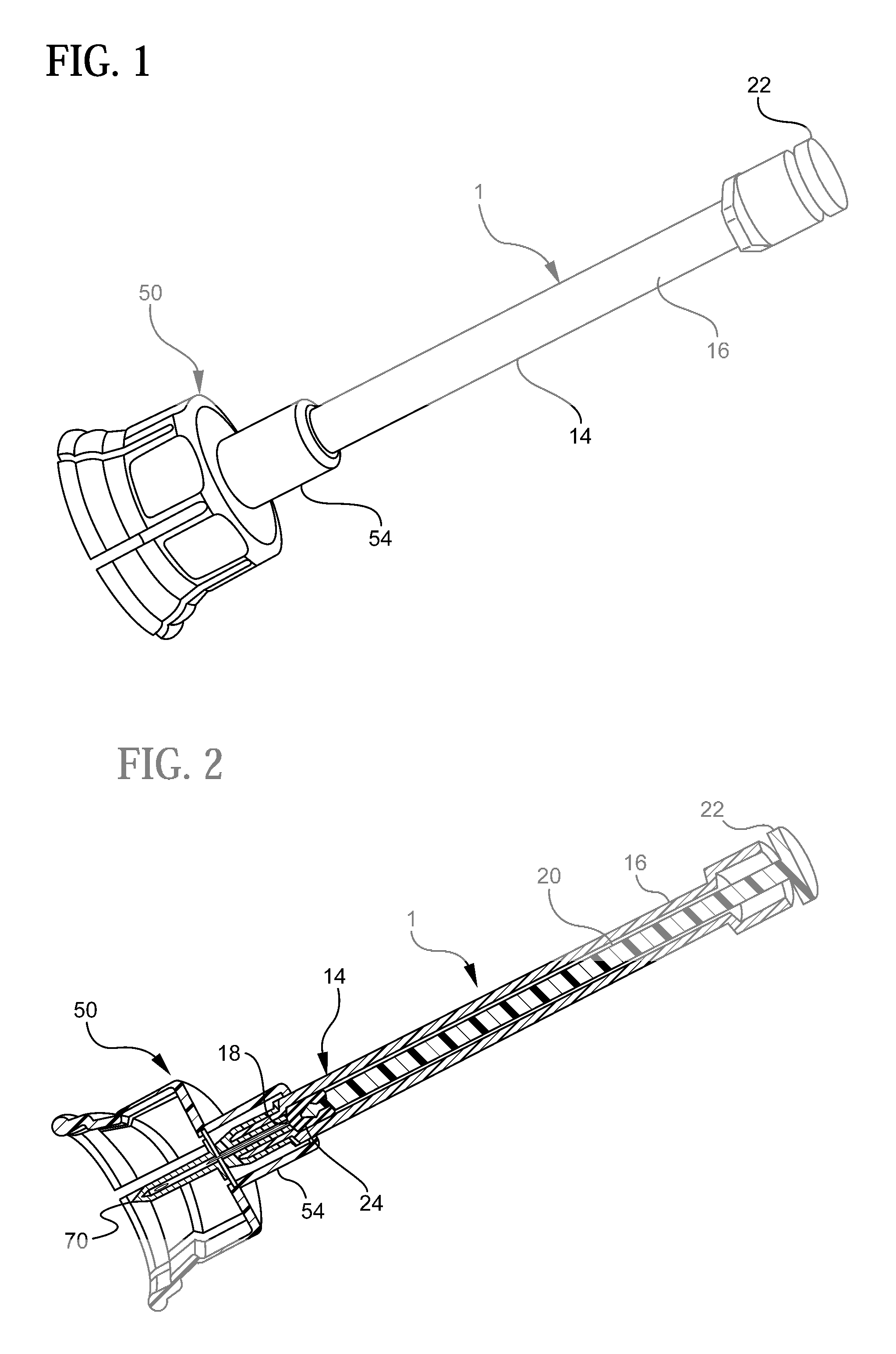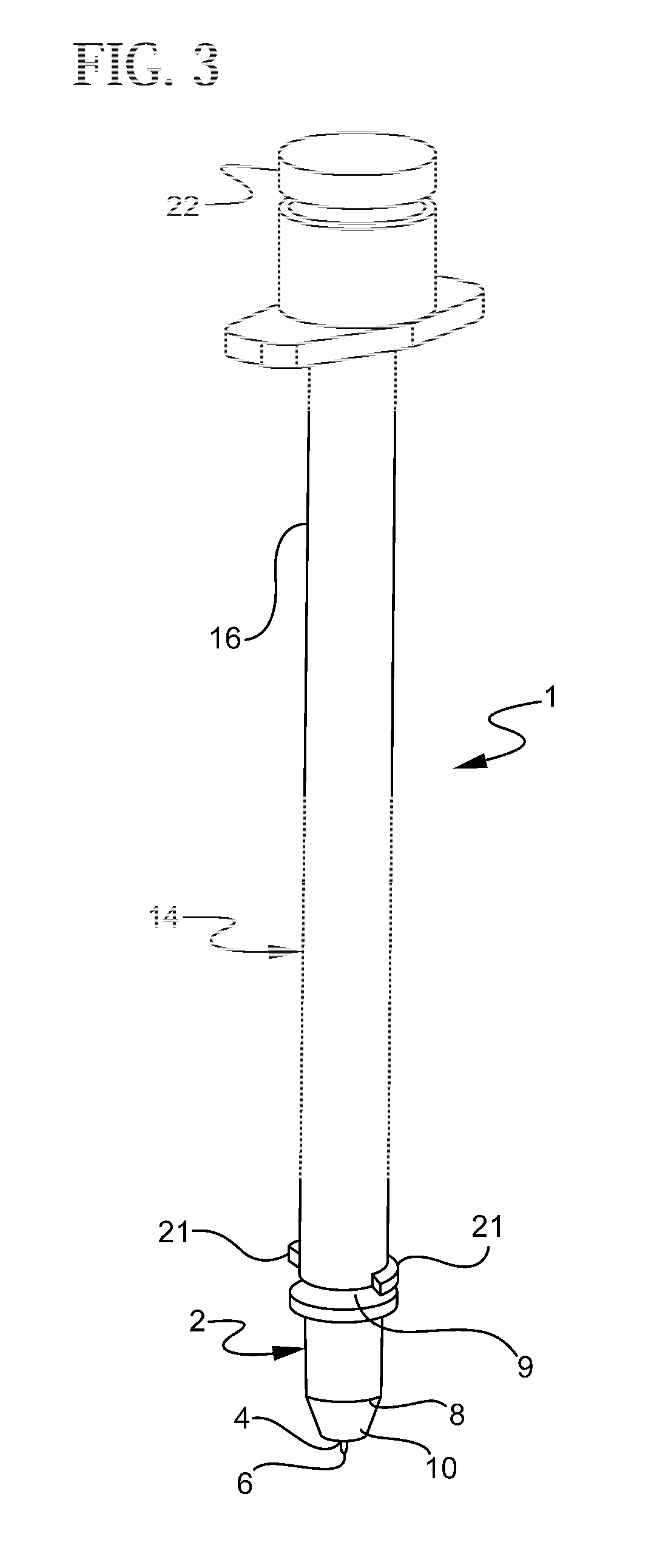[0010] An intradermal
injection device with a reservoir within which a drug substance may be held is able to be filled from a vial having a thick septum through the short needle by utilizing the device and method of one aspect of the invention. In accordance with one embodiment, the needle
assembly of the device to be filled is specifically designed for making intradermal injections; however the devices and methods of the invention may be useful in any situation where the septum or vial stopper of a medication container is thicker than the
usable length of the needle on the delivery device. The needle
assembly, in accordance with one embodiment, includes a penetration
limiter which permits a certain predetermined length of the needle cannula to protrude beyond the limiter a distance which limits penetration of the needle tip into the intradermal space of the patient's skin. In accordance with one embodiment, the needle tip extends beyond the skin engaging surface a distance
ranging from approximately 0.5 mm to 3 mm. The needle
assembly may be secured to the syringe via a hub portion, which may be integrally formed in the syringe body or the hub portion may be separate and detachably secured by a Luer fit or equivalent attachment method. As may be appreciated from FIG. 3, it is not possible, using a device having a stationary limiter at the short lengths required for intradermal injection, to fill a reservoir from a conventional vial having a septum of a thickness greater than the protrusion of the needle. The distance the needle protrudes from the limiter is too short to adequately penetrate the depth of the septum and access the substance contained in the vial. Aspects of the present invention allow for access to a substance contained in a conventional vial by an intradermal needle device or assembly. Alternatively, it may be desirable to pre-fill the syringe with a
diluent and use the devices and methods having aspects of the invention for mixing of
diluent and
active ingredient. Thus,
standard methods for preserving the therapeutic and / or diagnostic substances, such as maintaining them in liquid or
powder form in conventional vials for future use, may be used with the system of the present invention. Furthermore, using the intradermal filling devices having aspects of the present invention, it is possible to use conventional, inexpensive delivery devices such as fixed needle plastic syringes, in conjunction with the intradermal devices, which reduces dead-space and are often not appropriate for use as fill at
time of use devices.
[0012] Aspects of the present invention provide a fluid
transfer system for use in transferring a medical substance from a medication container having a septum with a pre-determined thickness into a delivery device. The delivery device has a reservoir adapted for storing a medical substance and a needle cannula attached to the delivery device with a lumen in fluid communication to the reservoir. The needle has a forward tip extending away from the delivery device a pre-selected
usable length, wherein the usable length is less than a thickness of a septum of the medication container. The system utilizes an adapter body which includes a container receiving portion with a septum access needle, and a longitudinal projection extending from the adapter body. The projection includes an adapter septum having a thickness less than the usable length of the needle cannula. When the container is inserted into the container receiving portion and the delivery device needle is penetrated through the adapter septum, fluid communication is established to the substance in the container such that it is allowed to be aspirated into the reservoir. Optionally, the system further comprises a shield which is slidably disposed upon the delivery device. The shield has at least a two positions, a first position exposing the forward tip of the needle cannula and a second position concealing the forward tip of the needle cannula. Optionally, the system further comprises a shield which includes at least one slot wherein the slot cooperates with a corresponding feature on the
vial adapter protrusion. Optionally, the
vial adapter protrusion includes at least one locking finger or tang received by the slot in the shield. Optionally, the locking features are disposed in a
helical pattern. In an alternate embodiment of the shield, the shield is slidably disposed upon the delivery device having at least a first position and a second position, the first position concealing said forward tip of said needle cannula and the second position exposing said forward tip of said needle cannula. Optionally, in this embodiment, a locking clip is used which is slidably disposed between the shield and the delivery device. The clip itself has at least two positions. A first position of the clip allows proximal movement of the shield with respect to the delivery device. The second position of the clip prevents proximal movement of the shield with respect to the delivery device. Optionally, movement of the shield with respect to the delivery device engages the clip and moves the clip into a second position of the clip, thereby preventing proximal movement of the shield with respect to the delivery device.
[0013] Additionally, a method of intradermally injecting a substance is provided including the steps of providing a
vial adapter for use with a vial having a septum with a pre-selected thickness, and providing an intradermal
injection device having a predetermined usable length of needle, inserting the vial into the vial adapter, inserting the intradermal device into the vial adapter, filling the intradermal device, removing the intradermal device from the vial adapter, and pressing the intradermal device to the patient's skin such that the skin engaging surface of the limiter encounters the skin and prevents penetration of the needle cannula deeper than about 3 mm; and injecting the substance under conditions and for a time sufficient to deliver the substance into the
dermis layer of the skin.
 Login to View More
Login to View More  Login to View More
Login to View More 


